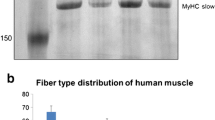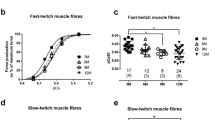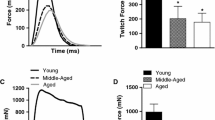Abstract
Muscle spindles are skeletal muscle mechanoreceptors that provide proprioceptive information to the central nervous system. The human adult masseter muscle has greater number, larger and more complex muscle spindles than the adult biceps. For a better knowledge of muscle diversity and physiological properties, this study examined the myosin heavy chain (MyHC) expression of muscle spindle intrafusal fibres in the human young masseter and young biceps muscles by using a panel of monoclonal antibodies (mAbs) against different MyHC isoforms. Eight MyHC isoforms were detected in both muscles-slow-tonic, I, IIa, IIx, foetal, embryonic, α-cardiac and an isoform not previously reported in intrafusal fibres, termed IIx′. Individual fibres co-expressed 2–6 isoforms. MyHC-slow tonic separated bag1, AS-bag1 and bag2 fibres from chain fibres. Typically, bag fibres also expressed MyHC-I and α-cardiac, whereas chain fibres expressed IIa and foetal. In the young masseter 98 % of bag1 showed MyHC-α cardiac versus 30 % in the young biceps, 35 % of bag2 showed MyHC-IIx′ versus none in biceps, 17 % of the chain fibres showed MyHC-I versus 61 % in the biceps. In conclusion, the result showed fundamental similarities in intrafusal MyHC expression between young masseter and biceps, but also marked differences implying muscle-specific proprioceptive control, probably related to diverse evolutionary and developmental origins. Finding of similarities in MyHC expression between young and adult masseter and biceps muscle spindles, respectively, in accordance with previously reported similarities in mATPase fibre type composition suggest early maturation of muscle spindles, preceding extrafusal fibres in growth and maturation.



Similar content being viewed by others
References
Banks RW (1994) The motor innervation of mammalian muscle spindles. Prog Neurobiol 43:323–362
Barker D, Banks RW (1994) The muscle spindle. In: Engel A, Franzini-Armstrong C (eds) Myology: basic and clinical, 2nd edn. McGraw-Hill, New York, pp 3333–3336
Cho M, Webster SG, Blau HM (1993) Evidence for myoblast-extrinsic regulation of slow myosin heavy chain expression during muscle fiber formation in embryonic development. J Cell Biol 121:795–810
Ecob-Prince M, Hill M, Brown W (1989) Immunocytochemical demonstration of myosin heavy chain expression in human muscle. J Neurol Sci 91:71–78
Eriksson P-O, Thornell L-E (1985) Heterogeneous intrafusal fibre type composition of the human masseter muscle: morphological and enzyme-histochemical characteristics. In: Boyd IA, Gladden MH (eds) The muscle spindle. Stockton, Glasgow, pp 95–100
Eriksson P-O, Thornell L-E (1987) Relation to extrafusal fibre-type composition in muscle-spindle structure and location in the human masseter muscle. Arch Oral Biol 32:483–491
Eriksson P-O, Thornell L-E (1990) Variation in histochemical enzyme profile and diameter along human masseter intrafusal muscle fibers. Anat Rec 226:168–176
Eriksson P-O, Eriksson A, Ringqvist M, Thornell L-E (1980) The reliability of histochemical fibre typing of human necropsy muscles. Histochemistry 65:193–205
Eriksson P-O, Butler-Browne GS, Thornell L-E (1994) Immunohistochemical characterization of human masseter muscle spindles. Muscle Nerve 17:31–41
Hoh JF (2002) ‘Superfast’ or masticatory myosin and the evolution of jaw-closing muscles of vertebrates. J Exp Biol 205:2203–2210
Hoh JF (2005) Laryngeal muscle fibre types. Acta Physiol Scand 183:133–149
Hoh JF, Hughes S, Kang LHD, Rughani A, Qin H (1993) The biology of cat jaw-closing muscle cells. J Comput Assist Microsc 5:65–70
Hughes SM, Cho M, Karsch-Mizrachi I, Travis M, Silberstein L, Leinwand LA, Blau HM (1993) Three slow myosin heavy chains sequentially expressed in developing mammalian skeletal muscle. Dev Biol 158:183–199
Kjellgren D, Thornell L-E, Andersen J, Pedrosa-Domellöf F (2003) Myosin heavy chain isoforms in human extraocular muscles. Invest Ophthalmol Vis Sci 44:1419–1425
Kwa SH, Korfage JA, Weijs WA (1995) Function-dependent anatomical parameters of rabbit masseter motor units. J Dent Res 74:1649–1657
Larsson L, Moss RL (1993) Maximum velocity of shortening in relation to myosin isoform composition in single fibres from human skeletal muscles. J Physiol 472:595–614
Léger JJ (1985) Institut National de la Santé et de la Recherche Médical, Unité 249, Montpellier, France
Liu J-X, Eriksson P-O, Thornell L-E, Pedrosa-Domellöf F (2002) Myosin heavy chain composition of muscle spindles in human biceps brachii. J Histochem Cytochem 50:171–183
Morgan DL, Proske U (1984) Non-linear summation of tension in motor units of toad slow muscle. J Physiol 349:95–105
Österlund C, Liu J-X, Thornell L-E, Eriksson P-O (2011) Muscle spindle composition and distribution in human young masseter and biceps brachii muscles reveal early growth and maturation. Anat Rec (Hoboken) 294:683–693
Österlund C, Lindström M, Thornell L-E, Eriksson P-O (2012) Remarkable heterogeneity in myosin heavy-chain composition of the human young masseter compared with young biceps brachii. Histochem Cell Biol 138:669–682
Ovalle WK, Smith RS (1972) Histochemical identification of three types of intrafusal muscle fibers in the cat and monkey based on the myosin ATPase reaction. Can J Physiol Pharmacol 50:195–202
Pedrosa F, Thornell L-E (1990) Expression of myosin heavy chain isoforms in developing rat muscle spindles. Histochemistry 94:231–244
Pedrosa-Domellöf F, Thornell L-E (1994) Expression of myosin heavy chain isoforms in developing human muscle spindles. J Histochem Cytochem 42:77–88
Pette D, Staron RS (1990) Cellular and molecular diversities of mammalian skeletal muscle fibers. Rev Physiol Biochem Pharmacol 116:1–76
Pette D, Staron RS (2001) Transitions of muscle fiber phenotypic profiles. Histochem Cell Biol 115:359–372
Rossi AC, Mammucari C, Argentini C, Reggiani C, Schiaffino S (2010) Two novel/ancient myosins in mammalian skeletal muscles: MYH14/7b and MYH15 are expressed in extraocular muscles and muscle spindles. J Physiol 588:353–364
Sambasivan R, Kuratani S, Tajbakhsh S (2011) An eye on the head: the development and evolution of craniofacial muscles. Development 138:2401–2415
Sawchak JA, Leung B, Shafiq SA (1985) Characterization of a monoclonal antibody to myosin specific for mammalian and human type II muscle fibers. J Neurol Sci 69:247–254
Schiaffino S, Gorza L, Sartore S, Saggin L, Ausoni S, Vianello M, Gundersen K, Lomo T (1989) Three myosin heavy chain isoforms in type 2 skeletal muscle fibres. J Muscle Res Cell Motil 10:197–205
Schiaffino S, Reggiani C (1994) Myosin isoforms in mammalian skeletal muscle. J Appl Physiol 77:493–501
Schiaffino S, Reggiani C (1996) Molecular diversity of myofibrillar proteins: gene regulation nd functional significance. Physiol Rev 76:371–423
Sciote JJ, Kentish JC (1996) Unloaded shortening velocities of rabbit masseter muscle fibres expressing skeletal or alpha-cardiac myosin heavy chains. J Physiol 492(Pt 3):659–667
Sewry CA, Uziyel Y, Torelli S, Buchanan S, Sorokin L, Cohen J, Watt DJ (1998) Differential labelling of laminin alpha 2 in muscle and neural tissue of dy/dy mice: are there isoforms of the laminin alpha 2 chain? Neuropathol Appl Neurobiol 24:66–72
Silberstein L, Webster SG, Travis M, Blau HM (1986) Developmental progression of myosin gene expression in cultured muscle cells. Cell 46:1075–1081
Soukup T, Pedrosa-Domellöf F, Thornell L-E (1995) Expression of myosin heavy chain isoforms and myogenesis of intrafusal fibres in rat muscle spindles. Microsc Res Tech 30:390–407
Soukup T, Pedrosa-Domellöf F, Thornell L-E (2003) Intrafusal fiber type composition of muscle spindles in the first human lumbrical muscle. Acta Neuropathol 105:18–24
Stedman HH, Kozyak BW, Nelson A, Thesier DM, Su LT, Low DW, Bridges CR, Shrager JB, Minugh-Purvis N, Mitchell MA (2004) Myosin gene mutation correlates with anatomical changes in the human lineage. Nature 428:415–418
Sternberger LA (1979) The unlabeled antibody (PAP) method, introduction. J Histochem Cytochem 27:1657
Thornell L-E, Eriksson P-O, Fischman DA, Grove BK, Butler-Browne GS, Virtanen I (1988) Human muscle spindle development. In: Hnik P, Soukup T, Vejsada R, Zelená J (eds) Mechanoreceptors development, structure and function. Plenum Press, New York, pp 39–44
Thornell L-E, Grove B, Pedrosa F, Butler-Browne G, Dhoot G, Fischman D (1989) Expression of slow tonic myosin in muscle spindle fibres early in mammalian development. In: Stockdale F, Kedes I (eds) Molecular Biology of Muscle Development, Alan R Liss, New York, pp 471–480
Weiss A, Schiaffino S, Leinwand LA (1999) Comparative sequence analysis of the complete human sarcomeric myosin heavy chain family: implications for functioanl diversity. J Mol Biol 290:61–75
Acknowledgments
The authors wish to thank Mrs Inga Johansson for excellent technical assistance and associate professor Albert Crenshaw for English revision and valuable comments. This work was supported by grants from the Department of Odontology, Umeå University, Västerbotten County Council and the Swedish Dental Society.
Author information
Authors and Affiliations
Corresponding author
Rights and permissions
About this article
Cite this article
Österlund, C., Liu, JX., Thornell, LE. et al. Intrafusal myosin heavy chain expression of human masseter and biceps muscles at young age shows fundamental similarities but also marked differences. Histochem Cell Biol 139, 895–907 (2013). https://doi.org/10.1007/s00418-012-1072-7
Accepted:
Published:
Issue Date:
DOI: https://doi.org/10.1007/s00418-012-1072-7




